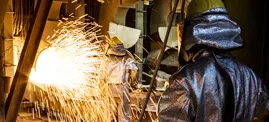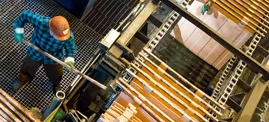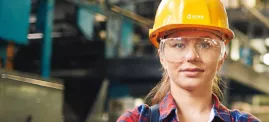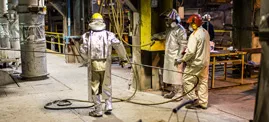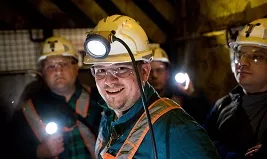Deposit mining technology
The deposit mining technology at KGHM Polska Miedź S.A. mines is based on in-house solutions developed in the course of the mining activity to date and combines technically advanced basic aspects of mining production, i.e. mining and transport, with maintaining the stability of the workings.
All elements of the production process are adapted to:
1. local conditions of deposition of deposits, including:
- form and depth of deposition of the deposit,
- lithographic-stratigraphic layout of the deposit and burden rock,
- occurring tectonic distortions,
- geomechanical properties of the rocks.
2. occurring natural threats, including the following threats which were and continue to be predominant during the individual stages of mining development:
- water threat (emerging especially during the sinking of the shafts - while passing through the waterlogged Tertiary and Quaternary strata, limiting also the possibility of entering into the southern parts of OG “Lubin” and OG “Polkowice”),
- bumps threat (the extent of this threat, which emerged in the early 1970s, determines the rules and terms of conducting works adopted at the mines, both in terms of mining technology, technical protection of the production and organisation of the working process),
- thermal threats (observed specifically in the deepest located parts of the deposit - level 1000m and deeper. The application of individual technical solutions in respect to assuring appropriate microclimate conditions is thus becoming even more significant, because the planned development of the mining will concentrate during subsequent years in the areas of the deposit at a depth below 1,200m.).
The mining of copper ore and its delivery to the ore enrichment plant is associated with the following technological operations:
- drilling of blasting holes,
- placement of explosives in the holes,
- construction of roof bolting,
- execution of ripping in the mine faces and access headings,
- transport of the production to the unit discharge places onto the belt conveyors,
- crushing of large rocks (excessive dimensions) on the unit discharge crate,
- transport of ore by belt conveyors (or by rail transport) to the crushing chambers by the shaft retention reservoirs,
- transport of the ore to the surface with using the skips of extraction shafts,
- transport of the ore by belt conveyor to ZWR (ore enrichment plant).
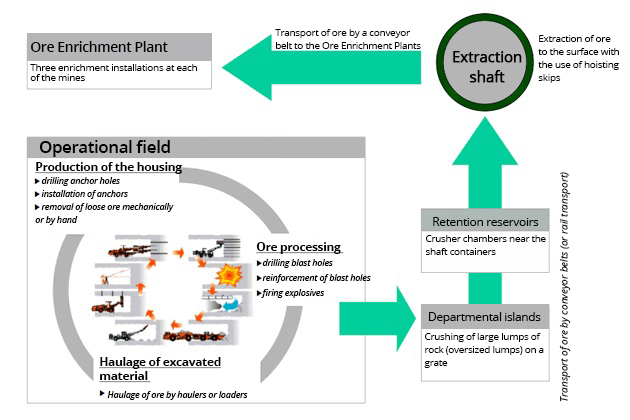
Ryc. Operacje technologiczne w procesie wydobywania rud miedzi
Deposit mining systems
Only the room-and-pillar mining systems are used at copper mines of KGHM Polska Miedź S.A. In these systems the body of the deposit is cut by the rooms and strips with separated technological pillars, which as a result of operational pressure are destroyed and switch into post-critical operating mode. The pillars separated in this manner work in the mining fields in respect to post-destruction carrying capacity in a similar to how the yielding chock support works. The technological pillars with their appropriately high carrying capacity allow maintaining the stability of the roof, while at the same time reduce the development of stratification of the direct roof and its excessive settlement in the working space of the mining front. The appropriate supporting capacity of technological pillars is achieved by appropriate selection of their dimensions and slenderness adapted to the local conditions of deposition of the deposit and strength properties of the rock mass. The basic varieties of the roof-and-pillar system with mined roof bending of the small and medium thick deposit now concern the systems with the liquidation of the extracted space by bending the roof on residual pillars left in the abandoned workings. The mining systems with hydraulic backfilling, on the other hand, are used in the mining of the parts of a thicker deposit or in areas requiring protection of surface structures.
The double-layer varieties of the roof-and-pillar system with liquidation of the extracted space by sand backfilling transported hydraulically, are used to mine deposits more than 7 metres thick. The varying strength properties of the rocks of the mined deposit and the roof result in the extraction of the layers from top to bottom. In this situation the roof of the preparatory and production workings is located in strong carbonate rocks. The bottom layer is made available by the inclined drifts from the floor of the upper layer. The thick deposit mining methods are also characterised by high differentiation associated with the local geological-mining conditions. The backfilling of the extracted space has a positive impact on the operation of residual pillars in the abandoned workings, increasing their supporting capacity and reducing the deformation of the roof and thus the extent of its settlement and impact on the surface.
The (various types of ) room-and-pillar systems developed in the course of mining to date, specifically in respect to deposits of medium thickness, were adapted to the local conditions of deposition of the deposits enabling maintenance of the assumed production capacity of the mines and minimisation of mining losses. The technology for thin deposits has also been developed, which would allow optimising the size of the mined deposit and ensure appropriate waste rock management. These activities result in:
- decrease in the quantity of mined waste rock in the production (decrease in dilution),
- reduced cost of mining, transport, processing and storage of post-flotation waste.

